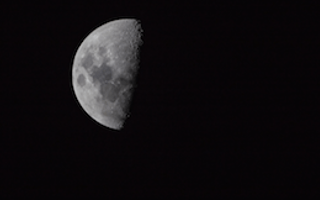
Most people don’t have access to an observatory telescope like this one at Boston University. But wouldn’t you want to see the moon as only astronauts have seen it before?
Blair DeWitt (pictured below), founder of startup Lunar Station, is betting he’s not the only one. 
On the evening of Thanksgiving 2015, DeWitt was sitting outside and admiring the beautiful full moon when he decided to run inside, grab his camera and take a photograph of it. A long-time aerospace fanatic, DeWitt has been passionate about exploring space since he was 10 years old and visited the Wright-Patterson Air Force Base in Ohio.
Unfortunately, the next day DeWitt discovered his photos didn’t turn out. He went online looking for a photo of the full moon he had seen and was surprised to find there were no websites offering real-time images of the celestial body.
“I was shocked,” DeWitt said. “Everyone has a GoPro. I thought maybe NASA would have some stuff, but I couldn’t find any real-time feed of the moon. That really was the start of this for me — the lack of engagement with the moon given the technology that we have today.”
At the time, DeWitt was finishing up his MBA from MIT Sloan School of Management and looking for the next opportunity. Prior to earning his MBA, DeWitt had been a software engineer at NASA, a global practice manager at EMC and founder of MiDrive, a data management company. He quickly decided his next venture would be Lunar Station.
With Lunar Station, DeWitt wants to provide people everywhere with a live-stream of the moon, which he plans on doing through a camera mounted to a private satellite. He’s partnered with Virgin Galactic to place the MoonWatcher Satellite into Low Earth Orbit (LEO) by 2018, which will provide viewers with an unobstructed, real-time feed of the lunar surface.
In addition to the satellite, the MoonWatcher Channel will deliver breakthrough scientific discoveries and the latest lunar news, DeWitt said.
Eventually, DeWitt said he hopes to expand people’s understanding of the moon’s resources via landers and rovers, and to one day deploy robots that will gather, process and supply resources like water, aluminum and titanium off the moon’s surface.
DeWitt launched a kickstarter to raise $150,000 for Lunar Station on Feb. 1, 2016 at the Cambridge Innovation Center and said he hopes to be the latest entrant into the “New Space” private sector.
DeWitt said he wants Lunar Station to be at the forefront of the aerospace industry paradigm shift. More and more often, funding for satellites, rockets and exploration is coming from private rather than public enterprises who are hoping to turn a profit through their missions.
“The lunar economy is developing very quickly,” DeWitt said. “This is the next commercial wave. With the MoonWatcher mission, our reconnaissance will be very optical in nature, but the fact that we eventually will have devices on the surface means we will have the opportunity to obtain the rights to those resources, and that’s where the other missions will start coming into play.”
DeWitt estimated it will take seven to 10 years to start processing ice found in the southern polar region of the moon for water and air, which could potentially be used for things like rocket fuel and hydration for lunar villages of the future.
A location in Kendall Square near his alma mater was important for DeWitt, who said his startup benefits from its proximity to MIT’s aerospace research community in addition to the startup community within the CIC.
For 2017, DeWitt said his biggest goal is to engage the community and get more people interested in learning about the moon.
“The clock is ticking for our rocket to launch, and we still have to build our satellite and get it to Virgin Galactic, which is exciting and thrilling,” DeWitt said. “I look forward to sharing that journey with our community.”
Photos via company
Know a startup worth profiling? Let us know or tweet us @BuiltInBOS



